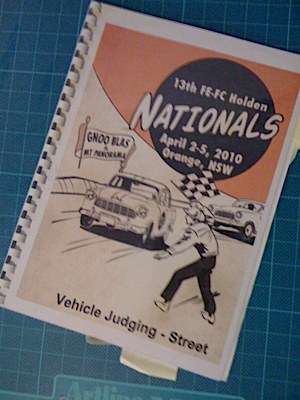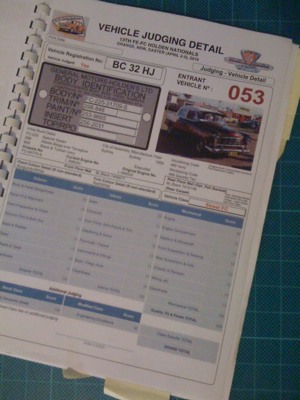|
 Judging Forms
Judging Forms | Judging Forms |

|

|
|
There's been some discussion on the forum regarding the methodology and forms used at this year's Nationals. For the benefit of entrants and future Nationals, we've published the forms and instructions used at Orange for you to download and analyse. There are also some comments about the logistics of how we did it for the benefit of Nationals Planners that come after us. Judging Books
A printed form was produced for each vehicle, including a photo, entrant number and licence plate detail, to ensure the car was accurately identified. The forms for all vehicles in each class were bound into a single book. Judges' InstructionsThis document was provided to the judges as the first page of the book, explaining how the scheme worked, and what they were to examine. Judging FormsAll vehicle were judged using the same judging sheet. As you can see once you download it, there is a section at the bottom left for the additional scoring for Stock and Modified vehicles. In the case of Stock Authenticity, this was a separate form, but for Modified vehicles, simply an additional cell to enter a result for Engineering, to be added to the total.
CommentsJudging Books and FormsThe scheme for judging at the Nationals is always evolving, and this was the first time we (the NSW Club) had run a Nationals since Professional Judging had been introduced. (It was also the first Nationals to have Street Class and Authenticity as a component.) Our Judges were enormously impressed with the book format, as it made it all but impossible to have transcription errors or "crossed wires" when it came to matching cars with forms. However, the lesson learnt was that the judging form was too finely detailed, and there were too many cells on the form that had to be individually assigned scores. This no doubt played a part in the delay to complete the judging. A suggestion from the judges for future Nationals is to group together more of the elements, so that rather than giving separate scores for "Seats (20)", "Door Trims, Kick Panels & Trim (15)", "Headlining & Visors (10)" and "Floormats/Carpet (10)", a single score out of 55 would allow them to more quickly assess each vehicle. Using comb-binding was also a mistake, as it made it difficult to move cars from one class to another. (The books had been printed and bound in Sydney, so late changes had to be stapled to the back of each book.) Hole-punching the sheets and putting them in a binder would have been better, as the sheets could have been moved from one to another more easily, and completed sheets removed and taken for tallying. By binding them together, we had to wait until judging was complete to get the books back from the judges and commence the tallying process.
Street ClassBy and large, the introduction of Street Class was a success. A suggestion from the Judges was that perhaps Street Class should be expanded to include more of the red motor powered vehicles, leaving Modified to the extensively engineered vehicles. The delegates will ponder that for 2012.
Top 20 / Top 40The old "Club Class" system was abandoned this year, replaced by a Summernats-style Top 20/Top 40 arrangement. I think on the whole this was quite successful, and fixed several glaring errors in the old scheme:
The number of vehicles in each class being judged was used to determine the proportion each class had of the Top 20 and Top 40. With 55 Stock, 26 Street and 40 Modified judged vehicles, the Top 20 were the best 9 Stock, best 4 Street and best 7 Modified vehicles, with Top 40 comprised of the next 9, 4 and 7 respectively. You could also choose to have Top X Stock, Top Y Street and Top Z Modified. We didn't, because we had already had the "TOP 20" number-plates made by the time the Top 20 / Top 40 system was endorsed by the delegates. AuthenticityObviously, the introduction of Authenticity as 25% of the total for Stock Vehicles had an impact on the results. Whether it tipped the results too far is something the delegates will have to consider for future Nationals. However, it is agreed that providing an incentive the maintain an unrestored car, or when it is restored, to do it in a manner faithful to the original, is an aim worth continuing with. |
| Newsflash | ||
|---|---|---|
|
||
| Polls |
|---|
| Who's Online |
|---|
| We have 3 guests online |
 All vehicles were classified into Stock, Street or Modified classes, as documented exhaustively elsewhere. Each vehicle had a coloured sticker placed on it, that identified its entrant number, class and whether it was to be judged or not.
All vehicles were classified into Stock, Street or Modified classes, as documented exhaustively elsewhere. Each vehicle had a coloured sticker placed on it, that identified its entrant number, class and whether it was to be judged or not.

